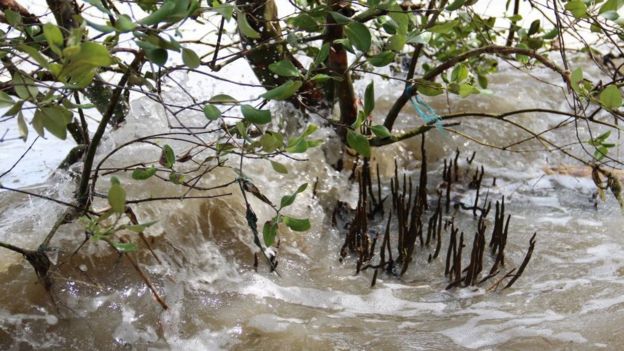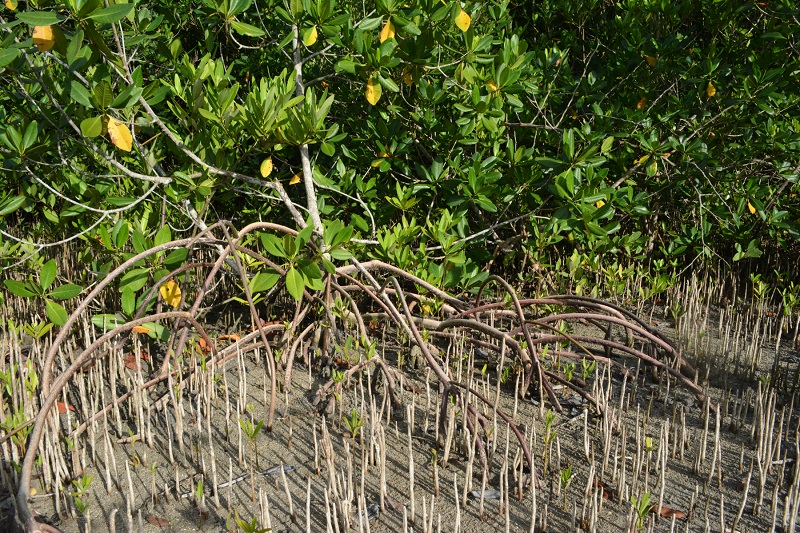What are mangroves?
Mangroves are a diverse group of about 70 species of trees and shrubs that live in the intertidal zone (transition from land to sea) in tropical and subtropical regions worldwide. Mangroves have number of unique adaptations that allow them to survive in an environment that is constantly changing as tides come in and out, causing the concentration of salt (salinity) to fluctuate and reach extremely high levels that would kill most species (Reef and Lovelock, 2015). In addition, as the tide comes in and the soil gets waterlogged it become anoxic (containing little to no oxygen which plants need for respiration). Before getting into a few of the amazing adaptations that enable mangroves to live in such dynamic and extreme environments, it’s important to understand why mangroves are so important to other animals, their ecosystem, and to humans.
 |
Red mangroves in Bonaire, S. Caribbean
© Hannah Rempel 2018
|
Why are mangroves so important?
Nurseries of the sea
We've all heard of schools of fish, but did you know that fish “kindergarten” isn’t on coral reefs? Mangroves and seagrass beds are called the nurseries of the sea because juvenile reef fishes and other critters begin their lives in seagrass beds, then migrate to mangrove roots where they can hide from predators and grow before making their way to corals reefs as they get older (Mumby et al., 2004; Nagelkerken et al., 2002). Ninety percent of marine critters spend part of their life in mangrove habitats (Sandilyan and Kathiresan, 2012), and 80% of the fish we catch depend directly or indirectly on mangroves at some stage of their life (Kjerfve and Macintosh, 1997).
 |
A juvenile (4cm) barracuda hides in mangrove roots,
© Hannah Rempel 2016
|
Buffering against erosion
Mangroves protect the coastline by acting as a buffer against storm surge and waves. Normal waves are reduced by about 80% for each kilometer of mangrove on a coastline (Das and Vincent, 2009; Miththapala, 2008). More importantly for humans, researchers found that after a super cyclone hit India, the death toll was far lower in villages with mangroves on the coastline than in villages with few to no mangroves (Das and Vincent, 2009).
 | |
| Mangroves help prevent coastal erosion and protect coastal communities from damaging storm surge, Photo by Wetlands International |
Carbon sequestration & climate change mitigation
Mangroves help mitigate climate change by taking up carbon dioxide from the atmosphere and using it to grow, in a process known as carbon sequestration. Mangroves are among the most carbon-rich forests and are responsible for 14% of the total carbon sequestration in marine habitats, known as “blue carbon” (Alongi, 2012). The graph below illustrates how mangroves have high levels of below ground storage of carbon compared to other forest ecosystems, making them an important part of keeping carbon dioxide out of the atmosphere (reprinted in Alongi, 2012 from Nature Geoscience 2011).
Human destruction of mangroves
Over the past half-century, approximately half of the world’s mangrove forests have been destroyed due to coastal development, clearing space for aquaculture of shrimp, and as a source of timber (Alongi, 2012). This can be countered through sustainable development practices that avoid developing wetlands, choosing to buy sustainably sourced shrimp and promoting replanting of mangrove forests. In order to preserve mangroves, it is also important to understand the critical role they play in protecting our environment and how they have uniquely adapted to survive in the extreme environment at the convergence between land and sea. Through this understanding we can better manage and conserve mangroves for future generations.
| Destruction of mangroves for coastal development on a shore in Belize © WWF-UK / Rebecca Absalom |
Adaptations and functions of mangroves
Living on the edge
Mangroves live in the intertidal zone where the salinity of the water and the soil they grow in fluctuates as the tide comes in or out. Not many plants are able to survive under such high salinity and oxygen stress, but mangroves have adapted a variety of physiological mechanisms that allow them to live in such an extreme environment and have less competition with other plants.
Getting to the root of it- root adaptations to limited oxygen
One issue for plants living in soil that is always or frequently inundated with water is that the soil has low to no oxygen. Most of us know that plants take in carbon dioxide, they also need oxygen for respiration. Similar to our use of snorkels in water, mangroves, like some Avicennia species, have specialized aerial roots called pneumatophores to breath when the rest of their roots are under water. Pneumatophores have pores on the side (like the opening at the top of a snorkel) called lenticels that allow the plant to transport oxygen to the rest of its root system under the waterlogged soil. It’s not everyday you hear of a plant “snorkeling”!
 |
| Black mangrove (Avicennia germinans) pneumatophores, From the Khaled bin Sultan Living Oceans Foundation |
Don’t be salty- Root adaptations to salt stress
| Rhizophora mangle roots, photo from Mangrove.at |
Hypersaline (extremely salty) environments can be toxic to plants and can cause bubbles to form (cavitation) in plant xylem (a straw like structure in plants that that transports water). These bubbles can stop the flow from the roots to the rest of the plant. Some mangroves take salt in from the surrounding water, but others like Rhizophora mangle have special root tissue that allows them to filter water. Mangroves block the passive transport of water into and through tissues by having high levels of fatty compounds like suberin that repel water in the barrier between the cell walls and plasma membrane in their roots. They also have a thick Casparian strip with a lot of suberin that forms a barrier between outer root tissue and vascular bundles that are responsible for transporting water, nutrients and sugars. Instead of passive water transport, mangroves control the movement and filtration of water and dissolved salts by having a high level of cell-to-cell water conducting protein channels called aquaporins, (Reef and Lovelock, 2015). When these aquaporins were blocked with mercury chloride in an Avicenna species and Rhizophora species of mangroves, it decreased the ability of these mangroves to transport water up through the roots to stomata (pores on the leaf) by 45-60% (Reef and Lovelock, 2015). This demonstrates just how important this mechanism is to control water transport and filtration in some mangroves!
Leave it on the leaf- leaf adaptations to salt and water stress
Some mangroves, like certain Avicennia species, secrete excess salts through glands on their leaves. Those salt crystals either wash off in the rain, or are discarded when leaves drop to the ground. When soil salinity increases, the rate at which some Avicennia species of mangroves excrete salt through these glands also increases. This was demonstrated in a 2013 study by Tan and colleagues who found that the amount of salts that mangroves secrete through these salt glands greatly increased as the concentration of salt in the external environment increased, shown below:
 | |
| (L) Salt crystals on the leaf surface of the Black Mangrove (Avicennia germinans), by Ulf Mehlig (R) Figure from Tan et al., 2013 |
Some scientists believe that the accumulation of salt crystals on leaves may serve a secondary purpose of helping mangroves take in water vapor from humid air where they don’t have to worry about filtering out salts (Reef and Lovelock, 2015). More research is needed to validate this idea with evidence- maybe you can be the one to prove that does so!
In addition to salt glands (shown in the lower left image), some mangroves have thick cuticle layers that help prevent water loss (shown in the upper right image). Some mangroves also have fine hairs on the underside of their leaves (shown in the lower right image) that help trap water condensation (dew) from the surrounding air - another source of fresh water! You can see these feature in microscope cross sections and slides from mangrove leaves below from Naskar and Palit, 2015:
Summary
 |
| A mangrove snapper hiding in Rhizophora mangle roots, © Hannah Rempel 2016 |
Mangroves are diverse group of trees and shrubs that live in the intertidal zone in tropical/subtropical regions worldwide. Mangroves have a variety of important functions such as being a nursery for fish, sequestering carbon, and protecting coastal communities from waves and storm surge. Mangroves also have a huge variety of physiological adaptations that allow them to live in the intertidal zone, such as aerial roots, specialized filtration of salt water in roots and excretion of salt through leaf glands. These examples were just a few of the remarkable adaptations of mangrove that allow them to survive in an environment with extreme fluctuations in salt, oxygen and access to low-salinity water. For a visual of these adaptations and more, see the summary figure from Reef and Lovelock, 2015 below:
Want to learn more?
Check out the references section of scientific papers on mangroves, or these short Youtube videos by mangrove expert Dr. Karen McKee on mangrove adaptations to salt and flooding:
References
Alongi, D. M. (2014). Carbon sequestration in mangrove forests. Carbon Manag. 3, 313–322.
Das, S. and Vincent, J. R. (2009). Mangroves protected villages and reduced death toll during Indian super cyclone. Proc Natl Acad Sci USA 106:7357–7360
Das, S. and Vincent, J. R. (2009). Mangroves protected villages and reduced death toll during Indian super cyclone. Proc Natl Acad Sci USA 106:7357–7360
Kjerfve, B., and
Macintosh, D. J. (1997). In: Kjerfve, B., Lacerda, L.D. and Diop, S. (Eds.),
Mangrove Ecosystem Studies in Latin America and Africa. UNESCO, Paris, pp. 1‐7.
Miththapala, S.
(2008). Mangroves. Coastal Ecosystem Series 2: 1-28, Colombo, Dri Lanka,
Ecosystems and Livelihoods Group Asia, IUCN
Mumby P. J.,
Edwards, A. J., Arias-González , J. E., Lindeman, K. C., Blackwell, P. G.,
Gall, A., Gorczynska, M. I., Harborne, A. R., Pescod, C. L., Renken H., Wabnitz
C. C. and Llewellyn, G. (2004). Mangrove enhance the biomass of coral reef fish
communities in the Caribbean. Nature 427:533–536
Nagelkerken, I.,
Roberts, C. M., Van der Velde, G., Dorenbosch, M., Van Riel, M. C., Cocheret de
la Morinière, E. and Nienhuis, P. H. (2002). How important are mangroves and
seagrass beds for coral-reef fish? The nursery hypothesis tested on an island
scale. Mar. Ecol. Prog. Ser. 244, 299–305.
Naskar, S. and
Palit, P. K. (2015). Anatomical and physiological adaptations of mangroves.
Wetl. Ecol. Manag. 23, 357–370.
Reef, R. and
Lovelock, C. E. (2015). Regulation of water balance in Mangroves. Ann. Bot.
115, 385–395.
Sandilyan, S.
& Kathiresan, K. (2012). Biodivers. Conserv. 21(14): 3523–3542.
Tan, W. K., Lin,
Q., Lim, T. M., Kumar, P. and Loh, C. S. (2013). Dynamic secretion changes in
the salt glands of the mangrove tree species Avicennia officinalis in response
to a changing saline environment. Plant, Cell Environ. 36, 1410–1422.
External image
sources
Destruction of mangroves for coastal development on a shore in Belize © WWF-UK / Rebecca Absalom
http://blogs.wwf.org.uk/blog/habitats/saving-belizes-mangrove-forests/
Mangroves help prevent coastal erosion and
protect coastal communities from damaging storm surge, Photo by Wetlands
International
https://ichef-1.bbci.co.uk/news/624/cpsprodpb/10DC6/production/_91226096_manroverootsdissipatingwavesbymarkspalding.jpg
Pneumatophores of black mangroves, from the Living Oceans Foundation
https://www.livingoceansfoundation.org/ngg_tag/black-mangrove-pneumatophores/
Rhizophora mangle roots, photo from Mangrove.at
http://www.mangrove.at/images/species/rhizophora_mangle/roots/rhizophora%20mangle%20roots%2004.jpg'
Salt crystals on the leaf surface of the Black Mangrove (Avicennia germinans), by Ulf Mehlig https://commons.wikimedia.org/wiki/File:Avicennia_germinans-salt_excretion.jpg
Personal image use
Images by Hannah Rempel are copyright material, please contact the author before using these images.











Really cool post! Awesome content and visuals and the thing about excreting saltwater was really interesting!
ReplyDeleteCan I forward this to friends in Switzerland?
ReplyDeleteI knew mangroves were important for young fish. I didn’t know they were important for carbon sequestration.
ReplyDeleteVery informative!
ReplyDelete